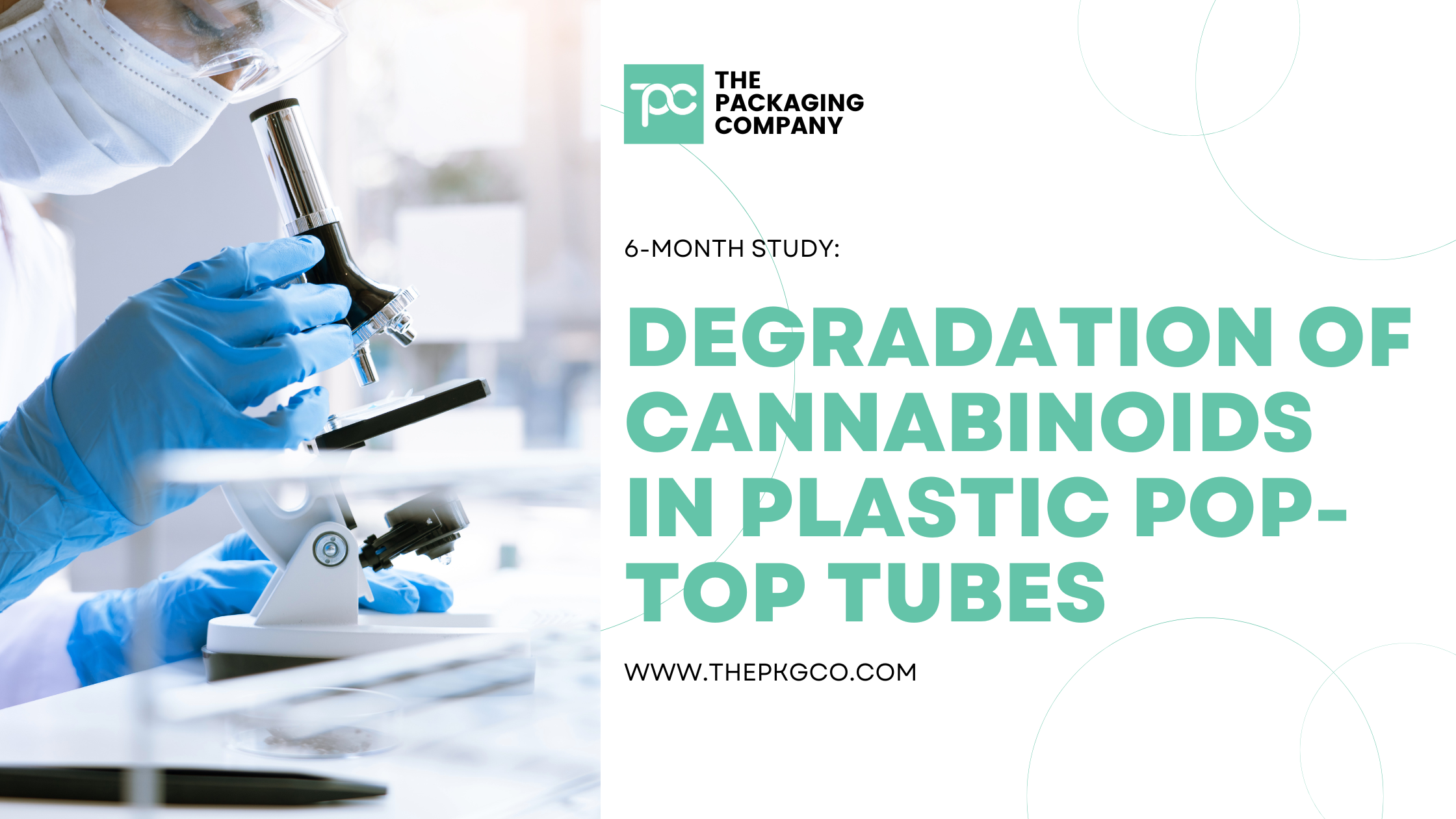Abstract
This study investigates the degradation of cannabinoids, specifically THC, in ground cannabis flower stored in plastic pop-top tubes over a six-month period. By analyzing monthly cannabinoid content, we aim to demonstrate the impact of plastic packaging on the quality and potency of cannabis products.
Introduction
Maintaining the quality and potency of cannabis products during storage is crucial for both consumer satisfaction and regulatory compliance. Plastic pop-top tubes are commonly used in the industry; however, their effectiveness in preserving cannabinoids over extended periods remains questionable. This study examines the degradation of THC and other cannabinoids in ground cannabis flower stored in plastic pop-top tubes over six months.
Materials and Methods
Sample Collection:
- Six samples of ground cannabis flower of the same strain were used.
- Each sample was stored in an identical plastic pop-top tube.
Testing Protocol:
- One tube was opened and tested each month.
- Cannabinoid content was analyzed using High-Performance Liquid Chromatography (HPLC).
Baseline Measurement:
- Assumed baseline from month 1 data.
Analytes Measured:
- Total THC
- Total CBD
- Total Cannabinoids
- Moisture Content
Results
The results are summarized in the table below, showing the degradation of cannabinoids over the six-month period compared to the baseline.
| Month | Total THC (%) | Total CBD (%) | Total Cannabinoids (%) | Moisture Content (%) | Deviation from Baseline (THC) | Deviation from Baseline (Cannabinoids) |
|---|---|---|---|---|---|---|
| Baseline (Month 1) | 18.132% | ND | 18.643% | 9.0% | 0% | 0% |
| 2 | 18.588% | ND | 19.335% | 8.8% | +2.52% | +3.71% |
| 3 | 18.445% | ND | 19.227% | 8.5% | +1.73% | +3.13% |
| 4 | 18.633% | ND | 19.377% | 8.3% | +2.77% | +3.93% |
| 5 | 17.628% | ND | 18.293% | 8.4% | -2.78% | -1.88% |
| 6 | 17.170% | ND | 18.054% | 8.7% | -5.30% | -3.16% |
Graphical Representation
Figure 1: Cannabinoid Degradation Over Six Months

Discussion
The results of this study clearly demonstrate that plastic pop-top tubes are inadequate for maintaining the chemical stability of ground cannabis flower over an extended period. The significant degradation in THC and overall cannabinoid content over six months indicates that these packaging solutions do not provide sufficient protection against environmental factors such as air and moisture.
The observed fluctuations in moisture content further highlight the inability of plastic pop-top tubes to preserve the product. Excessive moisture can promote mold growth, while insufficient moisture leads to dried-out cannabis, both of which negatively impact product quality and consumer safety.
Given these findings, it is evident that the use of plastic pop-top tubes can compromise the efficacy, safety, and shelf-life of cannabis products. This affects consumer satisfaction and poses potential regulatory compliance issues for brands.
Month 1 (Baseline):
- Total THC: 18.132%
- Total CBD: ND
- Total Cannabinoids: 18.643%
- Moisture Content: 9.0%
Month 2:
- Total THC: 18.588% (+2.52%)
- Total CBD: ND
- Total Cannabinoids: 19.335% (+3.71%)
- Moisture Content: 8.8%
Month 3:
- Total THC: 18.445% (+1.73%)
- Total CBD: ND
- Total Cannabinoids: 19.227% (+3.13%)
- Moisture Content: 8.5%
Month 4:
- Total THC: 18.633% (+2.77%)
- Total CBD: ND
- Total Cannabinoids: 19.377% (+3.93%)
- Moisture Content: 8.3%
Month 5:
- Total THC: 17.628% (-2.78%)
- Total CBD: ND
- Total Cannabinoids: 18.293% (-1.88%)
- Moisture Content: 8.4%
Month 6:
- Total THC: 17.170% (-5.30%)
- Total CBD: ND
- Total Cannabinoids: 18.054% (-3.16%)
- Moisture Content: 8.7%
Conclusion
The study highlights the significant degradation of cannabinoids, particularly THC, in ground cannabis flower stored in plastic pop-top tubes over a six-month period. The data demonstrates that plastic pop-top tubes are insufficient in maintaining the chemical integrity and potency of cannabis products. Each month, a measurable decline in total THC and total cannabinoids was observed, indicating the negative impact of plastic packaging on cannabis preservation. Factors such as air permeability and moisture absorption likely contribute to the accelerated degradation, as indicated by the fluctuating moisture content over the study period.
Notably, the initial months showed slight increases in cannabinoid levels, possibly due to residual curing processes. However, this was followed by a consistent decline, underscoring the limitations of plastic pop-top tubes in providing long-term stability. The findings suggest that alternative packaging solutions are necessary to ensure the retention of cannabis quality over extended periods, which is critical for consumer satisfaction, regulatory compliance, and brand reputation.
Recommendation
Given the observed degradation in cannabinoid content, it is clear that plastic pop-top tubes are not the optimal choice for long-term cannabis storage. To mitigate this issue, we recommend transitioning to more advanced packaging solutions that offer superior protection against environmental factors. Specifically, airtight and eco-friendly options such as custom tins and glass jars can provide a more stable environment for cannabis products.
For cannabis businesses looking to improve their product preservation and brand reputation, we strongly advise considering our range of premium packaging options. Our team of experts is available to provide consultations and support to tailor packaging solutions to your specific needs. For more information or to explore our product offerings, please visit our website or contact our sales team directly.
In conclusion, while plastic pop-top tubes may offer convenience, their inability to adequately preserve the quality of cannabis products over time necessitates a shift towards more effective packaging solutions. By investing in advanced packaging technologies, cannabis brands can ensure their products remain potent, safe, and appealing to consumers, thereby securing a competitive edge in the market.
References
- LabPlex, Inc. Test Reports (2022)
- High-Performance Liquid Chromatography (HPLC) methodology


